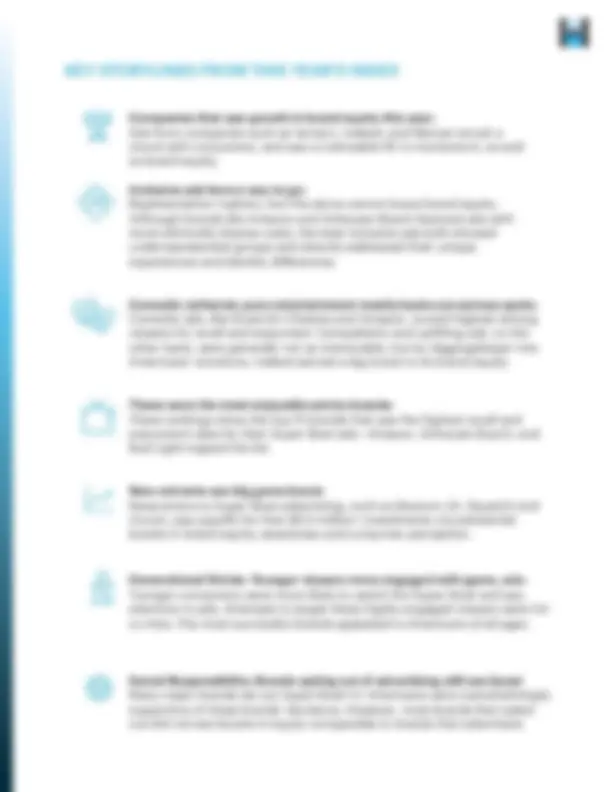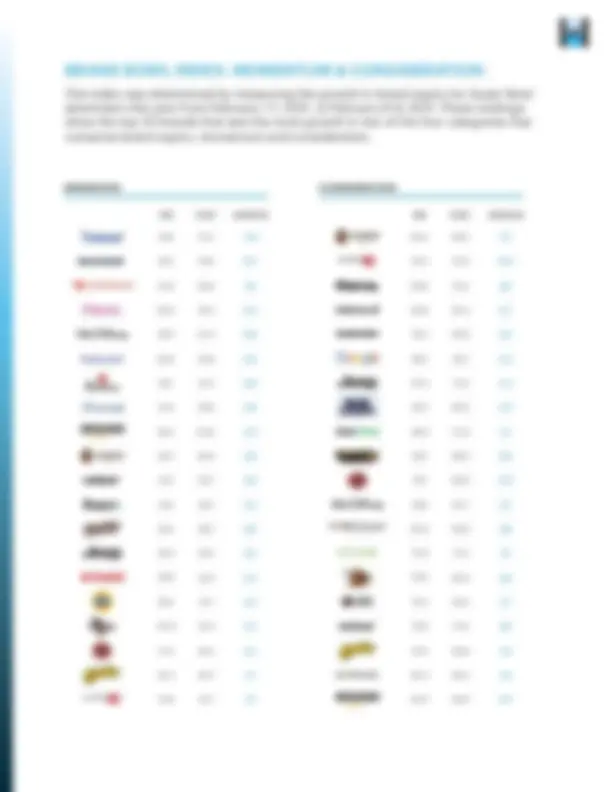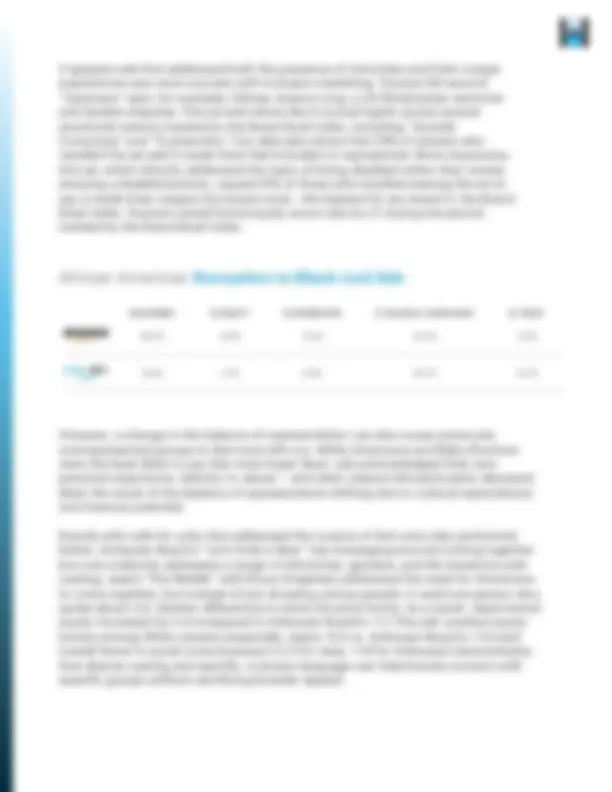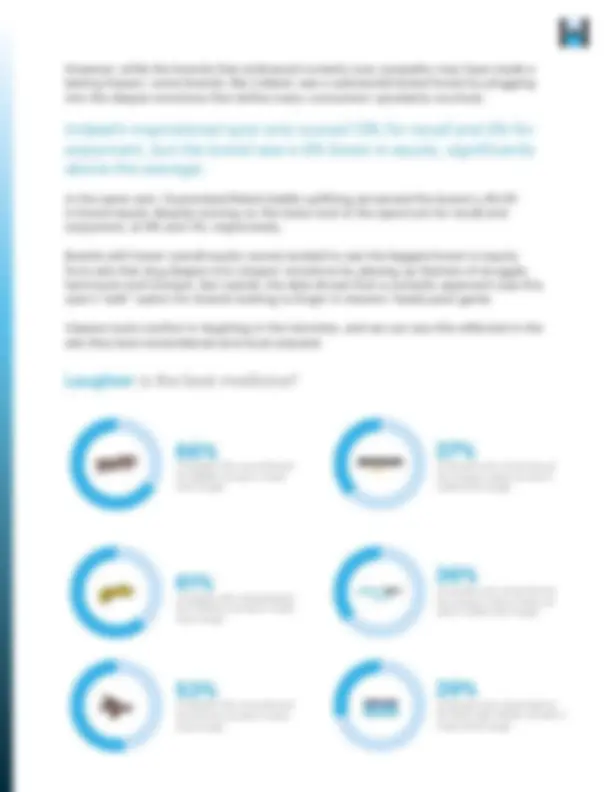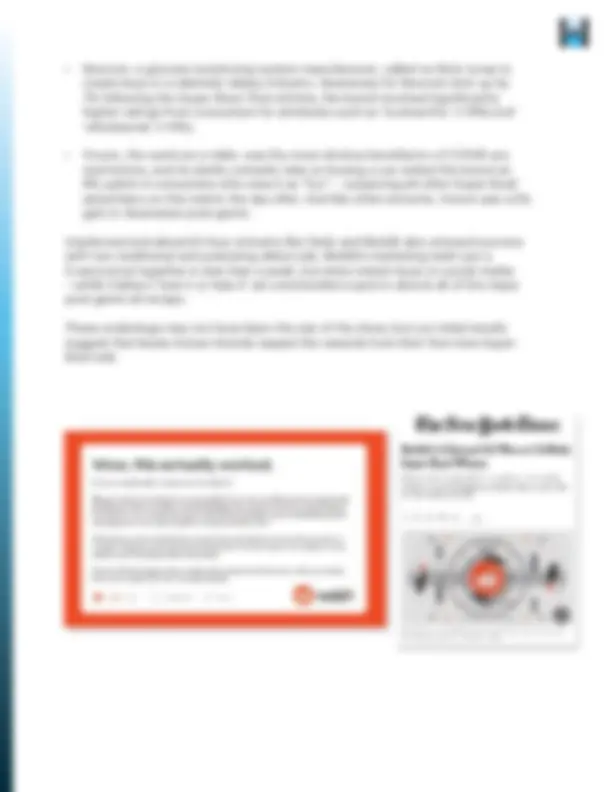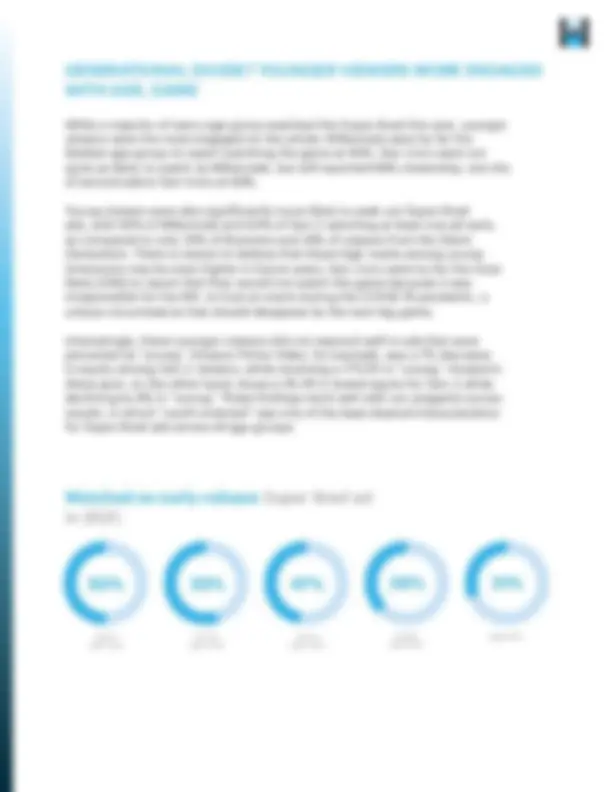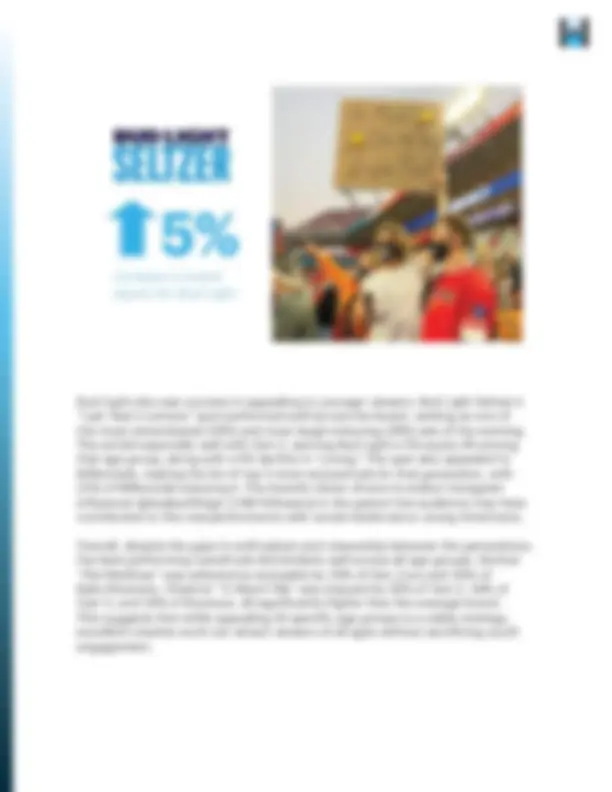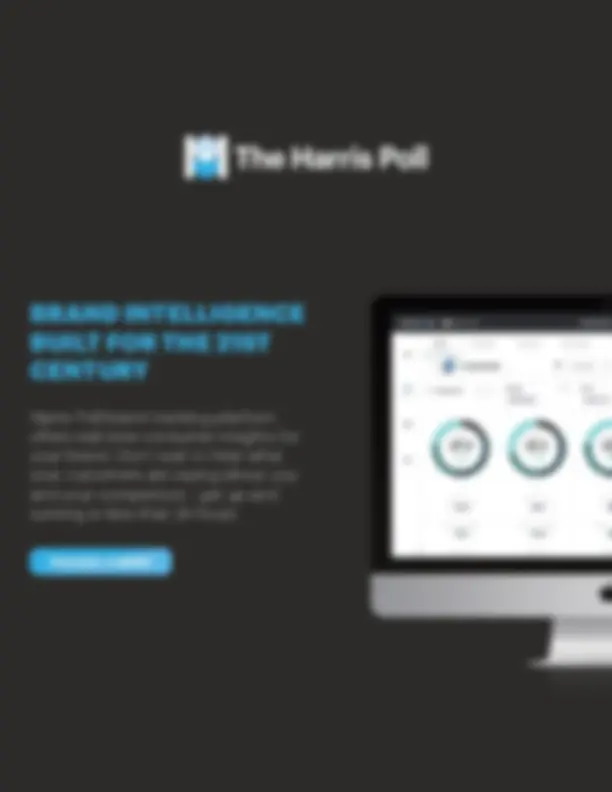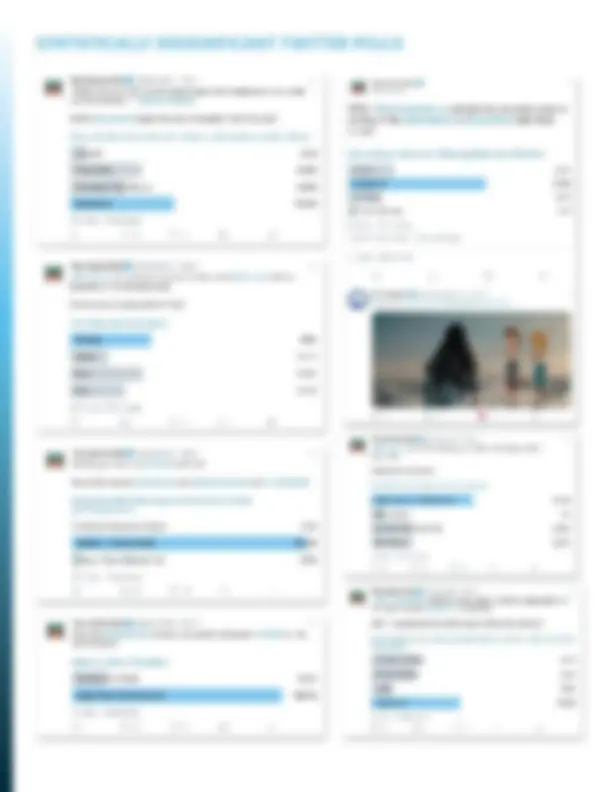Download Brand Bowl and more Summaries Medicine in PDF only on Docsity!
Brand Bowl
Introducing an Annual Index
on the Big Game’s Ad Impact
The Harris Poll’s 2021 Brand Bowl reveals the impact Super Bowl LV’s commercials (or
the lack thereof) had on brand equity for both emerging and established brands.
Most Super Bowl viewers preferred ads that were “funny or clever” (59%). Ads that
featured celebrities Americans liked also fared well, with 43% of viewers enjoying
these spots, as did commercials that were uplifting (42%).
According to our survey, 70% of Americans claimed to have watched this year’s Super
Bowl and 93% of watchers paid attention to the commercials. 82% tuned in on a TV,
with 60% using cable or a satellite and 23% streaming. 28% of viewers across all
devices used an official stream, compared with 10% who admitted watching on an
unofficial one. On Tuesday, Nielsen announced Super Bowl LV “drew an average TV
audience of about 92 million viewers” - the lowest since 2006.
Our Brand Bowl Index measures the change in brand equity-- the perceived value of
a company based on its reputation with its audience -- from February 1st to February
9th for companies who confirmed their intent to advertise during the Super Bowl by
February 4th, 2021.
The goal of this new index is to better understand which brands saw the largest gains
in brand equity after the Super Bowl on February 7th, 2021. It then drills down into
the four metrics that make up brand equity: momentum, consideration, quality, and
familiarity.
The Harris Poll’s brand tracking platform also measures key metrics that help
understand a customer’s progression through the purchase funnel -- awareness,
familiarity, trial, usage, and likelihood to recommend. Finally, it collects data on a wide
variety of emotional attributes that consumers associated with each brand.
HOW THE INDEX WAS DETERMINED WHERE THE DATA COMES FROM
harris poll brand tracking platform
Brand tracking platform polls thousands of people every day to provide real-time, global intelligence on thousands of brands. learn more
BRAND BOWL INDEX: BRAND EQUITY
This index was determined by measuring the growth in brand equity for Super Bowl
BRAND BOWL INDEX: MOMENTUM & CONSIDERATION
This index was determined by measuring the growth in brand equity for Super Bowl
advertisers this year from February 1-7, 2021, to February 8-9, 2021. These rankings
show the top 20 brands that saw the most growth in two of the four categories that
comprise brand equity: momentum and consideration.
post growth post
momentum consideration
INCLUSIVE ADS GARNER MODERATE SUCCESS
2021 saw a continued push from advertisers to run ads that accurately reflect America’s
diversity. This focus was reflected in both the content and casting of Super Bowl LV ads
aired by major brands. However, the tactics of diverse casting and broad, unity phrases
that worked in the past are less effective now. As time moves on from the Civil Rights
era and identities become more nuanced beyond race and gender to include income,
sexuality, values, and more, truly inclusive Super Bowl ads will need to address those
nuances to resonate with audiences.
Most Americans (76%) agree that Super Bowl commercials should feature people from
diverse backgrounds (e.g., ethnicity/race, sexual orientation, disability), and 82% of this
year’s Super Bowl viewers agreed that most of this year’s commercials had casting that
represented the diversity of the U.S. However, only 26% of viewers said they liked the ads
because they represented the diversity of the U.S., compared to 59% of Americans who
liked ads because they were funny or clever.
Digging deeper, many in minority groups were actually more critical of casting choices
in Super Bowl ads. When asked to measure the proportion of diverse Super Bowl ads,
only 11% of White Americans said less than half or none of the ads featured a diverse
cast (e.g., people of various ethnicities/races, sexual orientations). African Americans,
Hispanics, and those who identify as LGBTQ, disagreed more often (14%, 27%, and 32%,
respectively). Young adults, often more cognizant of representation, were also highly
critical. A third (33%) of Gen Z-ers disagreed that most ads featured a diverse cast,
compared to only 11% of Millennials, 16% of Gen X-ers, and 18% of all Super Bowl viewers.
Representation does yield higher enjoyment among targeted demographics, but this
does not always translate to brand equity improvements. Amazon Prime Video and
Amazon (Alexa) ran ads starring Black celebrities such as Eddie Murphy and Michael B.
Jordan. Across ethnicities, these spots rated the highest in enjoyment among African
Americans (34% and 26%, respectively). However, Amazon Prime Video dipped in equity
ratings (-0.8) among African Americans while Amazon saw a small lift (+1.7) after the
Super Bowl aired. Despite being ethnically relatable, both brands struggled to boost
overall equity in addition to brand momentum, social consciousness, and trust.
“At least half of the ads acknowledged my own personal experience , identity or values” Whites
Asian Americans
African Americans
Hispanics
LGBTQ
It appears ads that addressed both the presence of minorities and their unique
experiences saw more success with inclusive marketing. Toyota’s 60-second
“Upstream” spot, for example, follows Jessica Long, a US Paralympian swimmer
and double amputee. This ad and others like it scored highly across several
emotional metrics tracked by the Brand Bowl Index, including “Socially
Conscious” and “Trustworthy.” Our data also shows that 24% of viewers who
recalled the ad said it made them feel included or represented. More impressive,
this ad, which directly addressed the topic of being disabled rather than merely
showing a disabled person, caused 51% of those who recalled viewing the ad to
say it made them respect the brand more - the highest for any brand in the Brand
Bowl Index. Toyota’s overall brand equity score rose by 2.1 during the period
tracked by the Brand Bowl Index.
African American Reception to Black-Led Ads -0.8% +1.7% Δ equity -2.0% -10.7% Δ trust +2.3% -6.8% Δ momentum -14.3% -26.7% Δ socially conscious 26.0% 18.0% enjoyment
However, a change in the balance of representation can also cause previously
overrepresented groups to feel more left out. White Americans and Baby Boomers
were the least likely to say that most Super Bowl ads acknowledged their own
personal experience, identity or values -- and older viewers felt particularly alienated,
likely the result of the balance of representation shifting due to cultural expectations
and revenue potential.
Brands with calls for unity that addressed the nuance of that unity also performed
better. Anheuser-Busch’s “Let’s Grab a Beer” has messaging around coming together
but only indirectly addresses a range of ethnicities, genders, and life situations with
casting. Jeep’s “The Middle” with Bruce Singsteen addressed the need for Americans
to come together, but instead of just showing various people, it used one person who
spoke about U.S. identity differences to drive the point home. As a result, Jeep’s brand
equity increased by 2.4 compared to Anheuser-Busch’s +1.7. The ads’ positive equity
boosts among White viewers (especially Jeep’s +5.5 vs. Anheuser-Busch’s +1.0) and
overall boost in social consciousness (+2.2 for Jeep, +1.8 for Anheuser) demonstrates
that diverse casting and specific, inclusive language can help brands connect with
specific groups without sacrificing broader appeal.
However, while the brands that embraced comedy over sympathy may have made a
lasting impact, some brands, like Indeed, saw a substantial brand boost by plugging
into the deeper emotions that define many consumers’ pandemic-era lives.
Indeed’s inspirational spot only scored 15% for recall and 5% for enjoyment, but the brand saw a 6% boost in equity, significantly above the average.
In the same vein, Guaranteed Rate’s baldly uplifting ad earned the brand a 4% lift
in brand equity despite scoring on the lower end of the spectrum for recall and
enjoyment, at 8% and 2%, respectively.
Brands with lower overall equity scores tended to see the biggest boost in equity
from ads that dug deeper into viewers’ emotions by playing up themes of struggle,
hard work and triumph. But overall, the data shows that a comedic approach was this
year’s “safe” option for brands looking to linger in viewers’ heads post-game.
Viewers took comfort in laughing in the trenches, and we can see this reflected in the
ads they best remembered and most enjoyed.
of people who remembered
the Amazon Alexa ad said it
made them laugh
of people who remembered
the Amazon Prime Video ad
said it made them laugh
of people who remembered
the Bud Light Seltzer ad said it
made them laugh
of people who remembered
the Cheetos ad said it made
them laugh
of people who remembered
the Doritos ad said it made
them laugh
of people who remembered
the M&M’s ad said it made
them laugh
Laughter is the best medicine?
THE BRAND BOWL AD TRACKER
These rankings show the top 15 brands that saw the highest recall and enjoyment rates
for their Super Bowl ads. They were determined from a survey of U.S. adults aged 18+
who watched 2021 Super Bowl ads before or during the game, recalled seeing the ads,
and were randomly selected to answer follow up questions about the ad content.
Laugh • Want to buy from that brand Remember better times • Want to do good in the world Laugh • Respect the brand more Laugh • Respect the brand more Laugh • Want to buy from that brand Laugh • Remember better times Laugh • Want to buy from that brand Laugh • Respect the brand more Laugh • Respect the brand more Laugh • Want to buy from that brand Laugh • Want to buy from that brand Want to buy from that brand • Respect the brand more Laugh • Feel included or represented Laugh • Want to buy from that brand Respect the brand more • Want to buy from that brand recall enjoyment this ad made me...
- Dexcom, a glucose monitoring system manufacturer, called on Nick Jonas to
create buzz in a relatively sleepy industry. Awareness for Dexcom shot up by
7% following the Super Bowl. Post-airtime, the brand received significantly
higher ratings from consumers for attributes such as ‘trustworthy’ (+19%) and
‘wholesome’ (+14%).
- Vroom, the used car e-tailer, was the most obvious benefactor of COVID-era
restrictions, and its darkly comedic take on buying a car netted the brand an
8% uptick in consumers who view it as “fun” -- outpacing all other Super Bowl
advertisers on this metric the day after. And like other entrants, Vroom saw a 5%
gain in Awareness post-game.
Unplanned and eleventh-hour entrants like Oatly and Reddit also enjoyed success
with non-traditional and polarizing debut ads. Reddit’s marketing team put a
5-second ad together in less than a week, but drew instant buzz on social media
—while Oatley’s ‘love it or hate it’ ad commanded a spot in almost all of the major
post-game ad recaps.
These underdogs may not have been the star of the show, but our initial results
suggest that lesser-known brands reaped the rewards from their first-time Super
Bowl ads.
GENERATIONAL DIVIDE? YOUNGER VIEWERS MORE ENGAGED WITH ADS, GAME
While a majority of every age group watched the Super Bowl this year, younger
viewers were the most engaged on the whole. Millennials were by far the
likeliest age group to report watching the game at 83%. Gen Z-ers were not
quite as likely to watch as Millennials, but still reported 68% viewership, one shy
of second-place Gen X-ers at 69%.
Young viewers were also significantly more likely to seek out Super Bowl
ads, with 56% of Millennials and 40% of Gen Z watching at least one ad early,
as compared to only 33% of Boomers and 24% of viewers from the Silent
Generation. There is reason to believe that these high marks among young
Americans may be even higher in future years. Gen Z-ers were by far the most
likely (24%) to report that they would not watch the game because it was
irresponsible for the NFL to host an event during the COVID-19 pandemic, a
unique circumstance that should disappear by the next big game.
Interestingly, these younger viewers did not respond well to ads that were
perceived as “young.” Amazon Prime Video, for example, saw a 7% decrease
in equity among Gen Z viewers, while receiving a 17% lift in “young.” Amazon’s
Alexa spot, on the other hand, drove a 3% lift in brand equity for Gen Z while
declining by 8% in “young.” These findings track well with our pregame survey
results, in which “youth-oriented” was one of the least-desired characteristics
for Super Bowl ads across all age groups.
Watched an early-release Super Bowl ad in 2021: 50% 18- year-olds 55% 35- year-olds 47% 45- year-olds 38% 55- year-olds 31% Ages 65+
SOCIAL RESPONSIBILITY: BRANDS OPTING OUT OF ADVERTISING STILL SEE BOOST
Many perennial Super Bowl advertisers sat out this year’s game, some for financial
reasons and some to demonstrate a commitment to social responsibility during
the COVID-19 pandemic. Budweiser, for example, chose to divert the money that
would have gone into a big game spot towards promoting COVID-19 vaccination
efforts.
Americans surveyed before the game overwhelmingly supported Budweiser’s
decision, with 83% in favor. This support can also be seen in Budweiser’s brand
equity, which increased by 3% (from 47.5% to 50.8%) in the week following their
announcement. Between the week before the Super Bowl and the following
two days, AB InBev also enjoyed a boost in consumers who viewed the brand
as “socially conscious,” seeing a 2% increase in this description overall and a 4%
increase for the Bud Light brand in “socially conscious.” Michelob Ultra, who ran a
Super Bowl ad as usual, saw less than a 1% increase in the same metric.
Coca-Cola also opted out of advertising, but did not release a rationale or plan
like Budweiser, simply stating that they wanted to “invest in the right resources
during these difficult times.” Coke’s brand equity did not enjoy the same boost
as Budweiser, staying nearly flat with a 0.3% drop. While Budweiser’s success
demonstrates that sitting out was an effective PR tool for advertisers, the
comparison with Coke suggests that an opt-out must be well-planned and
communicated to match a Super Bowl spot’s impact.
Change in brand equity for brands who chose not to advertise during the big game:
METHODOLOGY
The brand equity index survey was conducted online within the United States
between February 1-7 among 1,651 adults (aged 18 and over) and February 8-9 among
1,648 adults (aged 18 and over) by The Harris Poll via its Brand Platform product.
Figures for age, sex, race/ethnicity, education, region and household income were
weighted where necessary to bring them into line with their actual proportions in
the population. Propensity score weighting was used to adjust for respondents’
propensity to be online.
The Super Bowl consumer sentiment survey was conducted online within the United
States by The Harris Poll on January 26-27 among 1,073 adults (aged 18 and over) and
February 7-9 among 1,109 adults (aged 18 and over. This online survey is not based
on a probability sample and therefore no estimate of theoretical sampling error can
be calculated. Figures for age, sex, race/ethnicity, education, region and household
income were weighted where necessary to bring them into line with their actual
proportions in the population. Propensity score weighting was used to adjust for
respondents’ propensity to be online.
Special thanks to Will Johnson, Abhish Raghavan, Amir Kanpurwala, Matthew Feider,
Zeke Huges, Justin Pincus, Aaron Kane, Annie Prunsky, Dami Rosanwo, Lucas Strombeck,
Aidan Krakowsky, David Zallis and the entire Harris Poll Brand team for their contribution
and effort in this project.
The Harris Poll is one of the longest-running surveys in the U.S., tracking public
opinion, motivations and social sentiment since 1963. It is now part of Harris Insights
& Analytics, a global consulting and market research firm that strives to reveal the
authentic values of modern society to inspire leaders to create a better tomorrow.
We work with clients in three primary areas; building twenty-first-century corporate
reputation, crafting brand strategy and performance tracking, and earning organic
media through public relations research. Our mission is to provide insights and
advisory to help leaders make the best decisions possible.
compass.theharrispoll.com
ABOUT US
STATISTICALLY INSIGNIFICANT TWITTER POLLS

